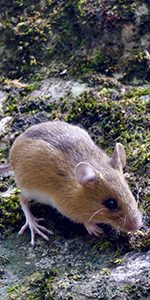| Woodland Jumping Mouse | ||
 |
Classification(s) : | Prey |
| Cat Name : | Jumping Mouse | |
| Common Name : | Woodland Jumping Mouse | |
| Scientific Name : | Napaeozapus insignis | |
| Other Name(s) : | ||
| Physical Description : | Woodland jumping mice are small furry creatures with brown to black backs, tan to orange sides, white bellies, large feet, long ankles, and long white-tipped tails which account for two thirds of their total length. |
|
| Physical Statistics : | Length: 8.3 – 10 Inches (210 – 255 Millimeters) |
|
| Behavior : | Woodland jumping mice are rarely found in open areas, hibernate during the winter, are nocturnal, and eat seeds, berries, fungi, and insects. |
|
| Social Organization : | Woodland jumping mice are tolerant of each other; home ranges overlap in both genders. They are not extremely social, however. |
|
| Approval Level : | None; Woodland jumping mice are fairly common and their presence does not suggest anything significant about the environment. | |
| Kill Difficulty : | Low; Woodland jumping mice are on the small side and have no weapons with which to defend themselves. |
|
| Training Level : | Advanced; While woodland jumping do forage on cloudy days, they are mostly nocturnal, and they can leap far; their erratic patterns of motion may also confuse the hunter. |
|
| Hunting Tactic : | Land Rodents | |
| Food Quality : | Medium; Though woodland jumping mice are small, they have nutritional value thanks to their diet. | |
